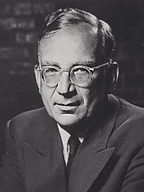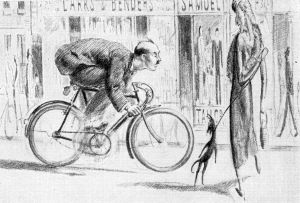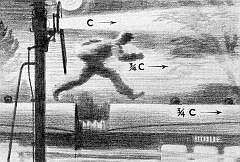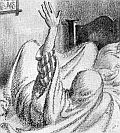|
Mr.
Tompkins in Wonderland - George Gamow
|
||||||
George Gamow was a brilliant physicist who made major contributions to 20th century physics. He worked with Niels Bohr in the development of quantum mechanics. During World War 2 he participated in the Manhattan project. After the war he became one of the chief advocates of the Big Bang theory. He was also a great popularizer of science with a wonderful sense of humor. (On one occasion, when he was about to publish a paper with his student Ralph Alpher, he mischievously added Hans Bethe's name to the paper, although Bethe had had nothing to do with it, just to make a pun on alpha-beta-gamma.) He has written several books on physics for laymen in addition to his Mr. Tompkins books, such as One, Two, Three - Infinity and Thirty Years That Shook Physics. In "Mr. Tompkins in Wonderland" his protagonist is a bank clerk who strays into a physics lecture. Of course, Mr. Tompkins does not understand much of what the professor is saying - his skills in mathematics are limited to addition, subtraction, multiplication and division, "of which he uses the first two in his profession". But he picks up enough interesting impressions to have a vivid dream related to the lecture. He likes his dream and comes back to enjoy additional lectures which in turn inspire new dreams.
Actually, notwithstanding the awe that surrounds Albert Einstein and his work, the Special Theory of Relativity published in 1905 is not that difficult to understand. It is certainly within the capacity of many bright 15-year-olds. It is just a question of working out the logical consequences of the empirical observation, that a measurement of the speed of light in vacuum always gives the same result, irrespective of the relative motions of the observer and the observed object. The difficult part is to integrate this with your "gut feeling" about how the world works.
In the late 19th century, it was quite a shock to scientists to find that the speed of light is constant to all observers. They tried to measure our planet's speed relative to the "ether", the medium that was believed to carry light waves, by sending light in different directions and having it reflected by mirrors, over carefully measured distances. The negative result was hard to explain. - Today we do not have to rely on tricky measurements to know that the speed of light is constant. In supernova explosions, large parts of a star are ejected in opposite directions at speeds of thousands of km/sec, i. e. at a significant fraction of the speed of light. If the speeds of those segments were additive/subtractive to the speed of light, we would expect a supernova explosion to be visible for centuries rather than weeks or months. - Direct measurements of the speed of light can nowadays be carried out with extremely great precision. The unit of length, the meter, has been formally re-defined as the distance that light travels in 1/299 792 458 of a second.
Einstein's greatest achievement was the General Theory of Relativity in 1915, ten years after he published his Special Theory of Relativity. While the Special Theory of Relativity deals with reference systems travelling at uniform speed relative to one another, the General Theory of Relativity concerns systems that accelerate with respect to one another. The starting point is two key observations: 1. Inertial mass is identical to "weighed" mass. The effects of gravity and of acceleration are identical. (Einstein described a thought experiment involving an accelerating elevator to demonstrate this.) 2. If one frame of reference rotates with respect to another, application of the Special Theory of Relativity leads to the conclusion that the geometry of the rotating system cannot be Euclidean. - The full implications of this are not as easy to deduce as in the case of Special Relativity, but Einstein was able to make two specific predictions that set his theory apart from Newtonian physics: a) Light bends around massive objects, so the apparent position of stars will shift slightly near the sun (observable during a total eclipse). b) The orbit of Mercury will precess in a way that can be precisely predicted. - Both of these predictions were confirmed within a few years. The dreams of Mr. Tompkins make an enjoyable path to understanding Relativity, but Einstein himself was quite good at explaining his theories to an educated lay audience, as can be seen from his book Über die spezielle und die allgemeine Relativitätstheorie published in 1916. An English translation is available here. - When it comes to Quantum Physics, Einstein's role was more that of "the Devil's Advocate". (See my musings about Quantum Entanglement.) An amusing aside: When my schoolmate and close friend Olav and I were 14 or 15, we went into an 8-storey building near our school just to ride the elevator up and down. (Elevators were a rarity at the time; there were few high-rise buildings in our suburb of Stockholm.) When an annoyed adult asked what we thought we were doing, Olav responded: "We are conducting Einstein's elevator experiment!". (Olav Kallenberg later had a career as a professor of probability theory at Auburn University.) |

 In
his dreams, Mr. Tompkins experiences some of the weird and counterintuitive
phenomena of the theories of Relativity and Quantum Mechanics. Gamow
uses the ingenious device of lowering the speed of light to 15 km/h
and of raising the value of Planck's constant by many orders of
magnitude in Mr. Tompkins dreams. The result is that relativistic
and quantum effects become noticeable in daily life. For instance,
Mr. Tompkins experiences length contraction in his surroundings
when he travels fast on his bike; and when he plays billiards, the
balls spread out in a probability cloud after each collision. The
lectures that trigger his dreams are included as appendices to the
book.
In
his dreams, Mr. Tompkins experiences some of the weird and counterintuitive
phenomena of the theories of Relativity and Quantum Mechanics. Gamow
uses the ingenious device of lowering the speed of light to 15 km/h
and of raising the value of Planck's constant by many orders of
magnitude in Mr. Tompkins dreams. The result is that relativistic
and quantum effects become noticeable in daily life. For instance,
Mr. Tompkins experiences length contraction in his surroundings
when he travels fast on his bike; and when he plays billiards, the
balls spread out in a probability cloud after each collision. The
lectures that trigger his dreams are included as appendices to the
book. 
